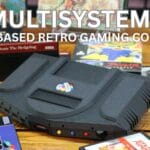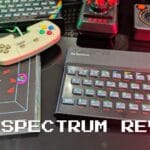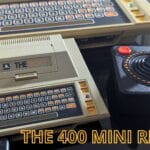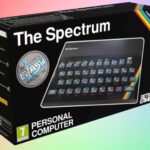Table of Contents
We restore a very yellowed and dirty Commodore Vic 20 back to its former glory. It’s got all the usual stuff; disassembly, cleaning up, more cleaning up, retrobrighting, assembly, and then seeing if the bleedin thing works OK. We also briefly check out the Pi1541 Disk Drive emulator.
Commodore Vic 20 Retro Restore Video
Commodore Vic 20 Retro Restore (Text)
As you can see, the Vic-20 is in a right state. The case is very yellowed and many years of dirt built up. There is some kind of stain on the right of the function keys which could be a problem when retrobrighting, we will see how that goes. And the grill at the top has been covered at some point, as it is not as yellowed as the rest.
I have powered it on and booted up a cartridge but thas as far as I have gone in terms of testing. I will do a full test after and if there are any issues I can look into them.
So before we begin, let’s do a quick history lesson on the Vic-20. The Vic-20 was launched in 1980, three years after Commodore’s first PC, the Commodore PET. It was sold for $300, which is around $800 in today’s money, and everyone complains about the Playstation and Xbox prices 🙂 It was also the first computer to sell over one million units.
Over the five year lifespan, there were a few different models. The first had a Commodore PET style keyboard. The second had the keyboard shared with early Commodore 64s. And later models had the newer C64 style grey keys.
Inside the Vic-20 you can find just 5KB of static RAM, the MOS 6502 CPU and the MOS Technology VIC video chip. There were over 300 titles available on cartridge and many more available on cassette tape. Peripherals included the Datasette tape, a disk drive and Super Expander Cartridges which ranged from 3KB up to 64KB.
Enough of the history lesson, lets get on with cleaning this poor thing up.
Case Disassembly
Opening the case is easy, there’s just three screws on the bottom to remove. Flip it back over and the top will open from the front on some clips on the back. Be careful when opening as there are wires for the keyboard and power led going from the bottom to the top half of the case.
The RF shield is a bit of cardboard with metallic foil on one side. Lifting this up gives a better look at the connections for the keyboard and LED which can then be removed, separating the two halves.
The motherboard can then be removed from the case by unscrewing several screws. The motherboard looks to be in good condition, no leaking capacitors, just a little bit of dust. We will clean this up later in the video.
The cheapo RF shield can now be removed and that’s the bottom half of the case disassembled.
The top half has the keyboard and power led, so we need to get those out. There’s several screws holding the keyboard in place and once removed the keyboard should come out fine.
Keyboard disassembly
The keyboard is in good condition, all the keys are pressable so there are no broken plungers. The text on the keys are a bit yellowed so we will clean those up and see if they need retrobrighting or not. Most likely there’s decades of dust and who knows what under the keys.
These keys are a pain in the arse to remove without a key puller, so please do get one if you are intending to remove any Commodore keys. Even with a puller, some keys can be very stubborn to remove. Also, be careful of springs going flying off and taking out an eye or something. I forgot the spacebar when removing, but gently lift it up and there will be a metal bar holding the key in place, with two grips on the actual keyboard.
As expected the keyboard base is full of dirt, dust and god knows what else. But there is no physical damage so we should be able to make this nice again.
Once all the keys have been removed, they can go in some warm water with a bit of fairy liquid to soak for 30 minutes or so. As always, not too hot otherwise you could make the keys soft and go out of shape.
While they are soaking, let’s take a look at the keyboard. Using a brush, I remove all the loose dirt before anything so it does not get clogged up everywhere. You can see how much has already come off 🙂
Now all the loose dust is off, I sprayed some isopropyl alcohol and let that work into the tougher dirt for a short white. Then with the brush, go over the keyboard again giving it a good scrubbing.
Then with some cotton pads wipe over the keyboard to remove the dust. These pads are very good, highly recommended! You can see how much dirt has come off.
I gave it a quick going over again with some alcohol and a cotton pad as there was still some grime refusing to go.
Then to finish up and remove any loose bits, I use the Compu Cleaner air blower to give it a good blast. This thing can push leaves around the garden, again highly recommended if you go through a lot of compressed air cans!
Case cleaning
Now on to cleaning the case, starting with the top half. First I need to remove the power LED. Using some pliers, you can remove the small plastic ring on the bottom, then flip the case over and push the LED through to the bottom.
This case is proper filthy, this video should have an 18 certificate… I start cleaning it with some warm water and fairy liquid to get a better look at the case. There is that strange stain on the right of the function keys which doesn’t look good.
The water is doing an OK job, but some of the dirt is proper stubborn to remove. So it’s time for some isopropyl alcohol and the missus toothbrush. After giving this a good scrubbing I am still not happy there is a lot of dirt so we will come back to this shortly.
I repeat the process for the bottom of the case. Warm water and fairy liquid, then some alcohol and toothbrush. Like the top half, some of the dirt is not coming out.
This has taken so long, I forgot about the keyboard keys and springs. So I am quickly taking them out of the water, cleaning and drying them with a towel. Some dirt has come off but the keys text is still a bit yellowed, so I will retrobright them for a short while to refreshen the colour.
And going back to the cases. I need to get this as clean as possible before retrobrighting. So I am going to try applying some baking soda and try scrubbing the dirt out. This acts as a very mild abrasive and lifts the dirt up when you work it in with a toothbrush. After some time, the majority of the dirt and stains were gone. But that stain on the right is still there, maybe it was a manufacturing fault or something scuffed it afterwards.
I repeat the process for the bottom half of the case and dry everything out, ready for retrobrighting.
Retrobrighting
The top half of the case is the most yellowed so I will be starting off with that. Check my Atari STFM retro restore video for more detailed information on retrobrighting as it will save time going over everything again in this one.
I covered up the Vic-20 and power badges with some masking tape to help keep the cream off. I use peroxide cream and a UV box as it’s autumn in the UK and the sun has buggered off until next year.
Get some cream on the brush and cover the keyboard, usually I do this in a pot but I instead thought to try pouring the cream straight onto the case to see if this helps with the distribution of cream. This does seem to work better. Make sure that all the surface is well covered, and that any grooves and edges are covered especially.
Once all covered, you can wrap it up in clingfilm to help keep the cream evaporating and drying out as fast as it would without it. Try and get it airtight as possible. And then it is put in the retrobrighting box, checking every couple of hours to massage the cream and that it has not dried out.
I then repeat the process for the bottom half. It rubs the lotion on the case. The yellowing is very uneven on the bottom so it will be interesting to see how this side turns out. Then I get it wrapped up in cling film and into the retrobrighting box.
And next up is the keyboard keys. The text is a little yellowed so I am going to put these to retrobright for a short while just to refreshen them. Only the top parts of the keys have cream on them as that is where it is needed.
To save time I have not shown any washing of the parts after they have been retrobrighted. Simply rinse them off with water and dry them with a towel and air blower if you have one.
Cleaning the motherboard
The motherboard itself is in good condition with no corrosion, leaking capacitors etc. So it just needs a general cleanup. I start with a quick air blow to remove any loose dust, and then a few sprays of alcohol and gently brush over with an antistatic brush. I repeat the process on the other side of the board.
The expansion contacts are looking a bit dull and dirty and it is always best to clean them with some contact cleaner. Spray some on the contacts and let it work in for a moment or two then use a cotton bud to clean the contacts. I recommend going up and down each contact instead of across as you may accidentally lift the contact from the motherboard.
Keyboard
Everything has been cleaned up and is hopefully still in working order. Now time to put everything back together and get it fully tested.
Starting with the keyboard keys. I like to separate the keys into alpha, numerical, function and symbol keys to find them a bit faster. All the keys have springs so first let’s get those put back on.
Then it is simply a case of referring to a keyboard photo and putting all the keys back on the keyboard. They push down on to the plunger fairly easily. Make sure they are fully pushed in.
Case
The crappy RF shield had a quick clean and simply slots into place via the screw holes on the bottom of the case.
The motherboard can then be fitted, again using the screw holes to align. Then we can add the screws for the board to the case. And thats the bottom half of the case complete.
The keyboard and power led need to be fitted to the top half of the case. Fitting the keyboard again just requires aligning the screw holes and putting the screws back in.
And for the power led, push the led through the hole, and you can simply push the plastic ring back in place.
Double check everything is looking OK and you have not forgotten everything. And then the power LED and keyboard cables can be reattached to the motherboard.
Join the top and bottom halves of the case together and flip it over. Screw in the case screws at the bottom and its job done. Time for the unveil!
Unveil
Before we get on to the unveil, let’s take a very quick look at the Vic-20 before. The case was very yellowed in most areas and there is a strange stain on the right side of the case. There are a few scratches here and there but mainly on the bottom of the case.
And here is how it looks now!
Overall the retro restore has gone well. However that stain on the right is still there, it definitely looks like a defect in the case as it goes through the plastic. Who knows, any ideas?
Other than that, all of the yellowing is gone and the case looks much more like how it should be. It’s not perfect, but much nicer to look at.
And now, lets get it powered on for a closer look
Demo
Everything is plugged up including a Commodore Datasette, Joystick and just out of sight, a Pi1541 which I will show later.
Powering on the Vic-20 shows the red light which is a good sign. There is a slight delay in the screen displaying anything as the video is going through an AV to HDMI convertor, then a capture card.
And we have life. I will check the keyboard first which appears to be working ok.
I have a bunch of Vic-20 game cartridges which were not working before. I have cleaned the cartridge contacts and can see if they now work. Starting off with Star Battle.
It seems to be working but the display is not centered, this might be from going through convertors and capture cards though. I will switch over to capture card for the rest of the games.
Star Battle is an OK Space Invaders clone, nice sound effects especially the bass.
Mole Attack is a whack a rat style game. It is a bit hard to play with the delay, but looks OK otherwise.
Voodoo Castle is a text adventure by the legendary Scott and Alexis Adams. I will definitely check this one out further after the video as I love text adventures.
Pi1541
Next up I wanted to try the Pi1541 which is a Commodore 1541 disk drive emulator running off a Raspberry Pi 3. I will show this in more detail in a future review but essentially it allows you to load disk images from a SD card into compatible Commodore devices such as the Vic-20, C64 etc.
There is a SD card file browser program which you can access as you would loading any disk. Simply select a compatible file such as a .prg and it will start to load it.
I was planning to show Astro Nell but unfortunately the joystick Left direction does not work so I will need to fix that. In the meantime, here is a quick look at Road Rally while I go over the retro restore.
Final Thoughts
Overall I am very pleased with the results. The case was extremely dirty and yellowed and I reckon it came up amazing looking compared to before. It is a pity I couldn’t get rid of the stain though, we will call it a battle scar 🙂
Apart from the Left direction on the joystick which I hope to fix shortly, everything is working great. I am waiting on a memory expansion board so we can check out the cool games and I will show it in the Pi1451 video which is coming soon. This has been a fun retro restore and the end result looks great!




